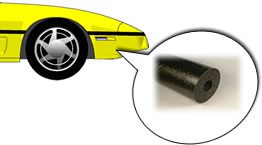Carbon Foam Bumper Applications

CFOAM® CARBON FOAM, BECAUSE OF ITS UNIQUE COMBINATION OF HIGH COMPRESSIVE STRENGTH AND CONSIDERABLE IMPACT ABSORPTION CAPACITY, IS AN ATTRACTIVE MATERIAL FOR ENHANCED PERFORMANCE BUMPER SYSTEMS.


Car bumpers generally consist of a tough plastic cover and underneath, a reinforcement framework made of steel, aluminum, fiberglass composite, or plastic.
To be effective, bumper systems also should include mechanisms that compress to absorb crash energy — polypropylene foam, plastic honeycomb, or other materials, and be designed with an appropriate distance between the reinforcement bar and the structure that it is to protect.
CFOAM® carbon foam’s cellular structure can be tailored by adjusting the cell wall thickness and pore size along one axis, resulting in a variable crush strength vs. penetration depth.
Shown here is a concept for a bumper system crush capsule made up of CFOAM® carbon foam with an axial guide hole wrapped in a high strength polymer composite sheet material. The capsules are placed in specially designed cylinder/plunger mechanisms which connect the bumper system to the protected structure.
CFOAM® carbon foam is expected to play an important role in energy absorption for automobiles, trucks, and race cars.
For more information on how CFOAM® carbon foam can enhance the performance in your vehicle, please call or email us.

